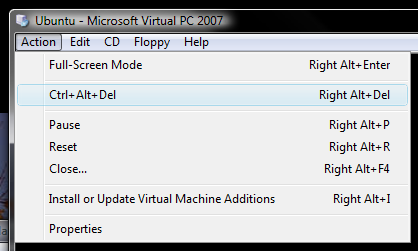If you’re used to using Control-Alt-Delete on a Windows PC to display the Task Manager and have recently switched to using a Mac, you’re probably wondering what the Mac equivalent to Control-Alt-Delete is.
Well, the bad news is that there isn’t a direct replacement. However, there are a few different ways to accomplish the same thing on a Mac, like force quitting applications or checking on the system resources being used by applications. In this article, we’ll show you how.

The alternatives to Control-Alt-Delete on a Mac
Ctrl + Alt + Delete: Mac Equivalent? Ask Question Asked 7 years, 6 months ago. Active 2 years, 4 months ago. Viewed 1.6m times 121. Ctrl + Alt + Delete on Windows provides a variety of functions, the main one of interest being the Task Manager. Is there an equivalent keyboard shortcut & indeed Task Manager for carrying out such tasks as. You are right, when the keyboard has a DEL button, CTRL-ALT-DEL works on a MAC. However, on notebooks and some smaller MAC keyboards (like the wireless keyboard), there is no DEL key. For example, I have a macbook air without the DEL key. Apple says you should press FN-BACKSPACE is the same as DEL. So the combination would be: CTRL-ALT-FN. But like me, my colleague was using a Mac and we don’t have an END key! Mac OSX Sent a Ctrl+Alt+END Sequence. If your RDP connected from OSX then use Ctrl+Alt+Fn+Backspace. If your RDP connected using a Mac Keyboard, or from a VM session on your Mac (i.e. From a VMware Fusion Windows Machine), then use Ctrl+Alt+Fn+Right-Arrow.
The closest equivalent to the well-known Windows keyboard shortcut on a Mac is Command-Option (Alt)-Escape. Pressing those three keys together pulls up a window displaying currently-running apps. It also shows you any apps that have hung and allows you to force quit them.
How to force quit applications on a Mac
- Press Command-Option-Escape.
- Choose the application you want to quit.
- Press Force Quit.
You can also access the Force Quit box from the Apple menu, by choosing Force Quit. And If you right-click or Control-click on a hung application in the Doc, an option to force quit it will appear in the contextual menu. If the Force Quit doesn’t appear, press the Option key while right-clicking, and you’ll see it.
How to see more information about applications on the Mac
Windows Task Manager does more than just allow you to force quit misbehaving applications. It displays a list of currently running processes and shows you the proportion of available system resources they’re using. These can both be viewed on your Mac using Activity Monitor, a very handy tool tucked away in the Utilities folder.
How to use Activity Monitor
- Go to Applications > Utilities.
- Double-click on Activity Monitor.
- Click on any tab, e.g. CPU, to see the percentage of resources being used by running processes.
- Click on any column header to order processes according to their value in that column. Click the column header again to reverse the order.
- If you see a process that’s taking up too many resources, select it and press the “X” button in the toolbar to quit it.
Control hung and heavy consuming apps with CleanMyMac X
Most of the time when your Mac is slow and unresponsive, there’s a particular app to blame. Some applications put too much pressure on Mac’s CPU making your whole system slow. Detecting and quitting those apps can considerably improve your Mac performance.
With CleanMyMac X, you can easily handle heavy consumers. It’s Optimization feature will identify hung applications and show you apps that are consuming lots of resources. CleanMyMac X is notarized by Apple, which proves it’s safe for your Mac.
Here’s how to manage heavy consuming apps:
- Download the free edition of CleanMyMac X and install it.
- Choose Optimization from the sidebar on the left.
- Press View All Items.
- Review the Hung Applications and Heavy Consumers sections.
CleanMyMac X also has a convenient menu bar item, which briefly informs you on current CPU load and memory status and lets you monitor CPU and disk usage, as well as free up RAM when you need to.
Manage login items

Login items are applications and utilities that launch when you log into your account. They run in the background so many users don’t notice them, until they start consuming too much memory.
In Windows you can manage login items using Control-Alt-Delete. Here’s how to do it on a Mac.
Control Alt Delete For Macbook
- Click the Apple menu and choose System Preferences.
- Go to Users & Groups.
- Select the Login Items tab.
- Click on any login item you want to remove.
- Press the “–” button at the bottom of the window.
Ctrl Alt Del For Macs
Force restart your Mac
Mac Keyboard Control Alt Delete Windows
If force quitting applications doesn’t solve problems you’re having with your Mac and the whole thing is frozen, you may need to restart it. However, if it has hung and all you can see is the beachball, you won't be able to use the restart option in the Apple menu. In this case, press and hold the power button until you see the Apple logo on the screen. If you have a MacBook with a Touch Bar, the power button is the Touch ID button.
Control Alt Delete For Mac Keyboard
There is no direct alternative to Control-Alt-Delete on the Mac, and the Mac doesn’t have a task manager like Windows. However, there are several things you can do to replicate the features available in Task Manager, like force quitting apps and viewing the status of resources on your Mac. CleanMyMac X can also warn you when system resources run low and help quickly free up RAM.
